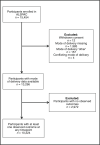Mode of delivery and maternal sexual wellbeing: A longitudinal study
- PMID: 35856885
- PMCID: PMC9804306
- DOI: 10.1111/1471-0528.17262
Mode of delivery and maternal sexual wellbeing: A longitudinal study
Abstract
Objectives: To investigate the association between mode of delivery and subsequent maternal sexual wellbeing.
Design: Prospective birth cohort study.
Setting: Avon (in Bristol area), UK.
Population: Participants in the Avon Longitudinal Study of Parents and Children (ALSPAC).
Methods: Mode of delivery was abstracted from obstetric records and sexual wellbeing measures were collected via a self-report questionnaire. Missing data were imputed using multiple imputation, and ordinal logistic regression models for ordered categorical outcomes were adjusted for the covariates maternal age at delivery, pre-pregnancy body mass index, diabetes during pregnancy, socio-economic position, parity, depression and anxiety.
Main outcome measures: Sexual enjoyment and frequency at four time points postpartum (between 33 months and 18 years) and two types of sex-related pain (pain in the vagina during sex and elsewhere after sex) at 11 years postpartum.
Results: We found no association between mode of delivery and sexual enjoyment (e.g. adjusted odds ratio [OR] 1.11, 95% confidence interval [95% CI] 0.97-1.27 at 33 months) or sexual frequency (OR 0.99, 95% CI 0.88-1.12 at 33 months). Caesarean section was associated with an increased odds of pain in the vagina during sex at 11 years postpartum as compared with vaginal delivery in the adjusted model (OR 1.74, 95% CI 1.46-2.08).
Conclusions: These findings provide no evidence supporting associations between caesarean section and sexual enjoyment or frequency. However, mode of delivery was shown to be associated with dyspareunia, which may not be limited to abdominal scarring.
Keywords: Avon Longitudinal Study of Parents and Children; caesarean section; dyspareunia; vaginal birth.
© 2022 The Authors. BJOG: An International Journal of Obstetrics and Gynaecology published by John Wiley & Sons Ltd.
Conflict of interest statement
None declared. Completed disclosure of interest forms are available upon request from the corresponding author.
Figures



Similar articles
-
Depressive symptoms, pain, and sexual dysfunction over the first year following vaginal or cesarean delivery: A prospective longitudinal study.Int J Nurs Stud. 2015 Sep;52(9):1433-44. doi: 10.1016/j.ijnurstu.2015.04.019. Epub 2015 May 7. Int J Nurs Stud. 2015. PMID: 26008134
-
Association of Mode of Obstetric Delivery With Child and Adolescent Body Composition.JAMA Netw Open. 2021 Oct 1;4(10):e2125161. doi: 10.1001/jamanetworkopen.2021.25161. JAMA Netw Open. 2021. PMID: 34623410 Free PMC article.
-
Sexual violence and mode of delivery: a population-based cohort study.BJOG. 2014 Sep;121(10):1237-44. doi: 10.1111/1471-0528.12923. Epub 2014 Jun 18. BJOG. 2014. PMID: 24939396
-
Dyspareunia and childbirth: a prospective cohort study.BJOG. 2015 Apr;122(5):672-9. doi: 10.1111/1471-0528.13263. Epub 2015 Jan 21. BJOG. 2015. PMID: 25605464
-
Folic acid supplementation and malaria susceptibility and severity among people taking antifolate antimalarial drugs in endemic areas.Cochrane Database Syst Rev. 2022 Feb 1;2(2022):CD014217. doi: 10.1002/14651858.CD014217. Cochrane Database Syst Rev. 2022. PMID: 36321557 Free PMC article.
Cited by
-
Pelvic floor-related sexual functioning in the first 24 months postpartum: Findings of a large cross-sectional study.Acta Obstet Gynecol Scand. 2025 Jan;104(1):203-214. doi: 10.1111/aogs.14990. Epub 2024 Oct 25. Acta Obstet Gynecol Scand. 2025. PMID: 39460381 Free PMC article.
-
Sexual experiences and behaviours of the parents in the Avon Longitudinal Study of Parents and Childhood (ALSPAC).Wellcome Open Res. 2024 Nov 6;9:240. doi: 10.12688/wellcomeopenres.21263.2. eCollection 2024. Wellcome Open Res. 2024. PMID: 39563947 Free PMC article.
-
The mother during pregnancy and the puerperium: Detailed data abstracted from the clinical obstetric records of ALSPAC pregnancies.Wellcome Open Res. 2024 Mar 26;6:41. doi: 10.12688/wellcomeopenres.16603.2. eCollection 2021. Wellcome Open Res. 2024. PMID: 38939328 Free PMC article.
-
Practice for Parturition: Does Sexual Activity Improve Labor and Birth Outcomes?Arch Sex Behav. 2025 Apr;54(4):1649-1669. doi: 10.1007/s10508-025-03117-2. Epub 2025 Apr 3. Arch Sex Behav. 2025. PMID: 40180704 Free PMC article. Review.
References
-
- Wise J. Alarming global rise in caesarean births, figures show. BMJ. 2018;363:k4319. - PubMed
-
- Wagner M. Choosing caesarean section. Lancet. 2000;356(9242):1677–80. - PubMed
-
- Bracken JN, Dryfhout VL, Goldenhar LM, Pauls RN. Preferences and concerns for delivery: an antepartum survey. Int Urogynecol J Pelvic Floor Dysfunct. 2008;19(11):1527–31. - PubMed
MeSH terms
Grants and funding
LinkOut - more resources
Full Text Sources
Medical

